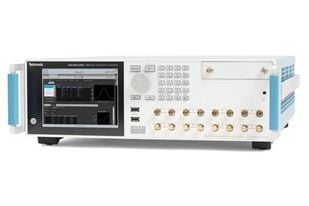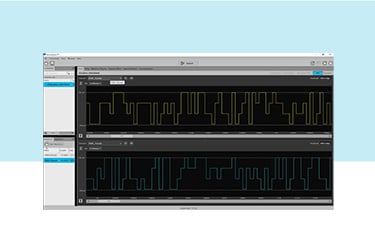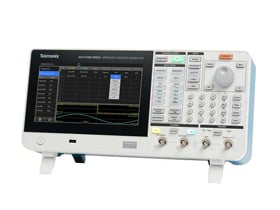お問い合わせ
ダウンロード
マニュアル、データシート、ソフトウェアなどのダウンロード:
フィードバック
任意波形発生器(任意波形ジェネレータ)
テクトロニクスの任意波形ジェネレータは、最大50GS/sのサンプル・レート、最大8チャンネル、そして複雑な信号の生成を簡略化するソフトウェア・パッケージを利用して、業界トップの性能を発揮します。非常に優れた柔軟性、速度、忠実度を誇るAWGは、高速シリアル、光通信、レーダ・テスト、電子戦に対応する、理想的なソリューションです。
任意波形発生器を比較し、最適な製品をお選びください。
関連製品:
任意波形発生器の特徴
テクトロニクスの任意波形発生器は、複雑なRF信号の生成と実環境のシミュレーションを1台の装置で実現する完全なソリューションを提供します。テクトロニクスの任意波形発生器を使用することで、下記が可能になります。
- 複数台の同期運転により、マルチチャンネルの高速AWGシステムを構築
- AWGのフロント・パネルから直接、波形の選択、編集、再生、イベントのトリガを素早く実行
- オシロスコープやスペクトラム・アナライザから取り込んだ信号の再生、編集、リサンプリングにより、実環境をシミュレート
- MATLABのようなサードパーティ・ツールから波形ベクトルをインポート
任意波形発生器によるレーダ信号の生成
複雑なレーダ信号を生成することは困難な作業になり得ます。この25分間の動画で、プロセスをより効率的にする方法を解説します。具体的には、独自の信号生成コードの記述とデバッグの複雑さを軽減する方法、複雑な信号を生成する際に避けるべき一般的な罠などについて説明します。
任意波形発生器に関するよくある質問(FAQ)
What is a waveform generator?
A waveform generator is a piece of electronic test equipment used to generate a variety of electrical signals. These signals act as a stimulus to a device under test (DUT), allowing engineers to verify a circuit's performance, troubleshoot issues, or simulate real-world conditions. The types of signals can range from simple, standard waveforms to complex, user-defined patterns.
What is the difference between a waveform generator and an arbitrary waveform generator (AWG)?
A waveform generator is a general term that refers to any instrument capable of producing electrical waveforms. This includes both function generators (also known as AFGs—Arbitrary Function Generators) and arbitrary waveform generators (AWGs). The key difference lies in waveform flexibility and complexity:
Function Generators / AFGs typically produce standard waveforms such as sine, square, triangle, and pulse. Some may offer limited arbitrary waveform capabilities, but they are generally optimized for ease of use and basic signal generation.
Arbitrary Waveform Generators (AWGs) are more advanced instruments designed to generate highly complex, user-defined waveforms with precise control over timing, amplitude, and shape. They are ideal for simulating real-world signals, such as sensor outputs, communication protocols, or distorted waveforms used in stress testing.
任意波形発生器の使い方は?
任意波形発生器は非常に使い勝手がよく、わずかな手順で回路の設計をテストすることができます。
- 出力制御を有効にする
- ワイン波,方形波,任意波などの波形の種類を選択
- 信号を可視化し捕捉するため、波形発生器をオシロスコープに接続
- 目的の周波数と振幅を設定
- 出力リード線を被測定機器に接続
任意波形発生器とファンクション・ジェネレータの違いは?
ファンクション・ジェネレータには、再生可能な波形やパターンがあらかじめ用意されています。オペレータは、再生速度や振幅、オフセットなどの波形パラメータを変更したり、基本的な歪みや変調を加えたりすることができます。
任意波形発生器は、より複雑な信号発生器で、想像できるほとんどの波形を作り出すことができます。任意波形発生器は高度な再生システムであり、AC信号の絶えず変化する電圧レベルを表す、保存されたデジタルデータに基づいた波形を提供します。プリセットされた一般的な波形ではなく、カスタムコンパイルされた波形を生成するために使用されます。
信号発生器にはどのような種類のものがありますか?
ファンクション・ジェネレータ、任意波形ジェネレータ、ベクトル信号発生器など、さまざまな種類の信号生成器があります。信号発生器にはいくつかの種類があります。それぞれの違いについて、下記のグラフをご覧ください。
| 信号発生器 | アナログ/デジタル電子信号源の一般的なカテゴリ名 |
| ファンクション・ジェネレータ | 信号発生器は、一般に、正弦波、波形、三角波などの一般的な波形が必要な場合に使用される |
| 任意波形/ファンクション・ジェネレータ | ファンクション・ジェネレータは、コンパイルされた任意波形を生成できる |
| 任意波形ジェネレータ | 任意波形ジェネレータは、あらかじめ用意された一般的な波形ではなく、コンパイルされたカスタム波形を必要とする場合に多く使用される |
| RF信号発生機 | RF信号発生器は、無線アプリケーションに使用され、通常のアナログ変調(AM、FM、PMなど)を提供する |
| (RF)ベクトル信号発生器 | RFベクトル信号発生器は、デジタル通信アプリケーションのためのRFキャリア上でのアナログとベクトルの両方の変調をサポートする |









